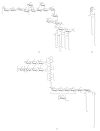The role of lipopeptidophosphoglycan in the immune response to Entamoeba histolytica
- PMID: 20145703
- PMCID: PMC2817369
- DOI: 10.1155/2010/254521
The role of lipopeptidophosphoglycan in the immune response to Entamoeba histolytica
Abstract
The sensing of Pathogen Associated Molecular Patterns (PAMPs) by innate immune receptors, such as Toll-like receptors (TLRs), is the first step in the inflammatory response to pathogens. Entamoeba histolytica, the etiological agent of amebiasis, has a surface molecule with the characteristics of a PAMP. This molecule, which was termed lipopeptidophosphoglycan (LPPG), is recognized through TLR2 and TLR4 and leads to the release of cytokines from human monocytes, macrophages, and dendritic cells; LPPG-activated dendritic cells have increased expression of costimulatory molecules. LPPG activates NKT cells in a CD1d-dependent manner, and this interaction limits amebic liver abscess development. LPPG also induces antibody production, and anti-LPPG antibodies prevent disease development in animal models of amebiasis. Because LPPG is recognized by both the innate and the adaptive immune system (it is a "Pamptigen"), it may be a good candidate to develop a vaccine against E. histolytica infection and an effective adjuvant.
Figures


References
-
- Araujo J, García ME, Diaz-Suárez O, Urdaneta H. Amebiasis: importance of the diagnosis and treatment. Minireview. Investigación Clínica. 2008;49(2):265–271. - PubMed
-
- Nari GA, Ceballos ER, Carrera Ladrón G, et al. Amebic liver abscess. Three years experience. Revista Española de Enfermedades Digestivas. 2008;100(5):268–272. - PubMed
-
- Graillet R, Sánchez Aguilar M, Morán-Mendoza AO, Hernández-Sierra JF, Gordillo-Moscoso A, Tapia-Pérez JH. Analysis of factors associated to failure of medical treatment of amoebic liver abscess. Cirugía Española. 2008;84(2):83–86. - PubMed
-
- Pritt BS, Clark GC. Amebiasis. Mayo Clinic Proceedings. 2008;83(10):1154–1160. - PubMed
Publication types
MeSH terms
Substances
LinkOut - more resources
Full Text Sources

